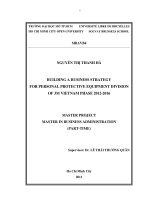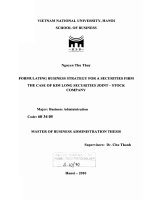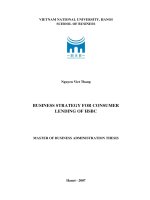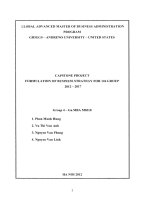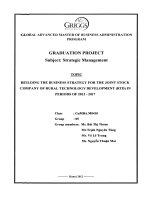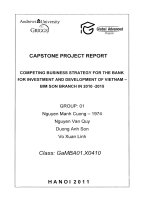DEVELOPMENT OF BUSINESS STRATEGY FOR NAMHA GARMENT STOCK COMPANY
Bạn đang xem bản rút gọn của tài liệu. Xem và tải ngay bản đầy đủ của tài liệu tại đây (1.08 MB, 84 trang )
BUSINESS STRATERGY OF NAM HA GARMENT STOCK COMPANY IN 2009-2015
THESIS
DEVELOPMENT OF BUSINESS STRATEGY FOR
NAM HA GARMENT STOCK COMPANY
1
BUSINESS STRATERGY OF NAM HA GARMENT STOCK COMPANY IN 2009-2015
ACKNOWLEDGEMENTS
Firstly, we would like to give my deeply appreciation to Faculty Group for their
comments. We also want to give many thanks who offer us support throughout the
academic year.
We guarantee this capstone project is our team’s research. It was gathered from
multiple sources and the actual document. This capstone project is not copied from
any research before. We are completely responsible for the content of this capstone
project.
Hanoi, August 11th 2009
2
BUSINESS STRATERGY OF NAM HA GARMENT STOCK COMPANY IN 2009-2015
TABLE OF CONTENTS
ACKNOWLEDGEMENTS ............................................................................................ 2
TABLE OF CONTENTS ................................................................................................ 3
INTRODUCTION ........................................................................................................... 9
CHAPTE R 1:LIT E RATURE REVIE W AND THE ORETI CAL BA SIS .. 11
1.1 Business strategy: Concepts and classifications. ............................................... 11
1.1.1 The different views of Corporation business strategy. ................................... 11
1.1.1.1 Classical views. ....................................................................................... 11
1.1.1.2 Evolution views. ...................................................................................... 11
1.1.1.3 According to process views. .................................................................... 12
1.1.1.4 Systems views ......................................................................................... 12
1.1.2. The concept of business strategy ................................................................... 12
1.1.3 Classifications of business strategy ................................................................ 13
1.1.3.1 General Strategy. ..................................................................................... 13
1.1.3.2 Functional strategies ................................................................................ 15
1.2 Planning business strategy process .................................................................... 16
1.3 Develop business strategy. ................................................................................. 17
1.3.1 Analysis the impacts of macro environment. ................................................. 17
1.3.1.1 Analysis the impacts of economics. ........................................................ 18
1.3.1.2 Analysis the impacts of politics. .............................................................. 19
1.3.1.3 Analysis the impacts of social. ................................................................ 19
1.3.1.4 Analysis the impacts of technology. ........................................................ 22
1.3.2 Using Porter’s Five Forces model to analyze business sector. ....................... 22
1.3.2.1 Analysis the rivalry among competitors. ................................................. 22
1.3.2.2 Analysis the bargaining power of buyers. ............................................... 26
1.3.2.3 Analysis the bargaining power of suppliers. ........................................... 26
1.3.2.4 Analysis potential new entrants. .............................................................. 27
1.3.2.5 Analysis the threat of substitute products................................................ 31
1.3.3 Enterprise analysis. ......................................................................................... 31
CHAPTER II: ANALYZE THE SITUATION OF NAM HA GARMENT STOCK
COMPANY. .................................................................................................................. 36
2.1 Introduce about Nam Ha Garment Stock Company .......................................... 36
2.1.1 Introduce about Nam Ha Garment Stock Company ....................................... 36
2.1.2 The process of formation and development.................................................... 36
2.1.3 Functions, responsibilities and organization structure of Nam Ha Garment
Stock Company: ....................................................................................................... 37
2.1.3.1 Functions: ................................................................................................ 37
2.1.3.2 Organization structure of Nam Ha Garment Stock Company. ................ 38
3
BUSINESS STRATERGY OF NAM HA GARMENT STOCK COMPANY IN 2009-2015
2.1.4 Quality Standard. ............................................................................................ 40
2.2 Analyze macroeconomic environment .............................................................. 41
2.2.1 Economics. ...................................................................................................... 41
2.2.1.1 The growth of the economy. .................................................................... 41
2.2.1.2 Inflation ................................................................................................... 42
2.2.1.3 Unemployment rate. ................................................................................ 43
2.2.1.4 Exchange rate. ......................................................................................... 44
2.2.2 Analysis the impact of politic events .............................................................. 44
2.2.3 Analysis of impacts from law and policies ......................................................... 47
2.2.4 Analysis of impact by social conditions ......................................................... 51
2.2.5 Analysis of impact from technology change .................................................. 52
2.3 Analysis of environment of garment and textile industry ................................. 53
2.3.1 Analysis the rivalry among competitors. ........................................................ 53
2.3.1.1 The competitors of Nam Ha Garment Stock Company. ......................... 53
2.3.1.2 Analyis of rivalry of competitors ............................................................ 56
2.3.1.3 Making the table of position assessment of Nam Ha Garment Stock
Company compared to its competitors ................................................................ 59
2.3.2 Analysis of customers’ pressure ..................................................................... 61
2.3.2.1 Classification of customers...................................................................... 61
2.3.2.2 Analysis of customers’ position .............................................................. 62
2.3.3 Analysis of suppliers pressure ........................................................................ 62
2.3.4 Analysis of pressure from potential competitors ............................................ 63
2.3.5 Analysis of pressure from substituted product ............................................... 63
2.4 Analysis of internal situation of Nam Ha Garment Stock Company. ............... 63
2.4.1 Analysis of productivity.................................................................................. 63
2.4.2 Financial analysis ............................................................................................ 66
2.5. Summary of opportunity, risks, strong points, weak points of the Company .. 71
CHAPTE R III: B U SINESS STRAT ER GY OF N AM H A GARME NT
STOCK COMPAN Y IN 2009 - 2015. .................................................................. 73
3.1 Summary the situation of Nam Ha Garment Stock Company. .......................... 73
3.2 General strategy of Nam Ha Garment Stock Company in 2009-2015. ............. 75
3.3 Functional strategy of Nam Ha Garment Stock Company ................................ 75
3.4 Implementing functional strategies of Nam Ha Garment Stock Company. ...... 79
Using Value chain Model to apply functional strategies. ........................................ 79
3.4.1 Infrastructure. .................................................................................................. 79
3.4.2 Human Resources Management. .................................................................... 79
3.4.3 Technology Development. .............................................................................. 80
3.4.4 Procurement. ................................................................................................... 80
3.4.5 Operations and Logistics. ............................................................................... 80
3.4.6 Marketing, Sales and Services. ....................................................................... 81
CONCLU SION ......................................................................................................... 82
REFERE NCES .......................................................................................................... 83
4
BUSINESS STRATERGY OF NAM HA GARMENT STOCK COMPANY IN 2009-2015
I. Vietname se Sources. .......................................................................................... 83
II. English Sources. ................................................................................................ 84
5
BUSINESS STRATERGY OF NAM HA GARMENT STOCK COMPANY IN 2009-2015
LIST OF TABLES
Table
Name
2.1
GDP of Vietnam in 2006 – 2009
2.2
Inflation rate of Vietnam in 2006-2009
2.3
Unemployment rate of Vietnam in 2006-2009
2.4
List of Domestic competitors
2.5
Turnover of Nam Ha Garment and competitors in US and EU market in
2008
2.6
Assessment of rivalry of Nam Ha Company compared to its competitors
2.7
Market share of competitors of local market
2.8
List of international customers of Nam Ha Garment Stock Company
2.9
Export turnover of Nam Ha Garment Stock Company in 2008
2.10
Productivity of the company in 2006-2008
2.11
Company’s Profit& Loss in 2007-2008
Solvency and profit of the company in 2007-2008
2.12
2.13
Capital structure of the company in 2007-2008
2.14
Organization by profession and skill
6
BUSINESS STRATERGY OF NAM HA GARMENT STOCK COMPANY IN 2009-2015
2.15
2.16
3.1
Summary of opportunities and threats of Nam Ha Garment Stock
Company
Summary of strengths and weaknesses of Nam Ha Garment Stock
Company
SWOT Matrix
7
BUSINESS STRATERGY OF NAM HA GARMENT STOCK COMPANY IN 2009-2015
LIST OF FIGURES AND GRAPHS
Figure 1.1 The Five Forces That Shape Industry Competition
Figure 2.1 Organization structure of Nam Ha Garment Stock Company.
Figure 2.2 Quality Standard of Nam Ha Garment Stock Company
Figure 3.1 Value Chain Model
8
BUSINESS STRATERGY OF NAM HA GARMENT STOCK COMPANY IN 2009-2015
INTRODUCTION
1. The necessity of project.
Enterprises when involve in the market have to define the specific long-term goals
and long-term business strategy for development. However, the existence and
development of a business not only depends on the enterprises’ activities but also
affected by many factors. The changes of business environment and the demands
are these enterprises’ opportunities but also are the challenges for other enterprises.
To develop, the enterprises have to determine policies and strategies to take full
advantage of business opportunities and limitations at risk. From that, the enterprise
can enhance the effectiveness, competitiveness and performance of business.
Therefore, business strategy cannot be missing, it is very important for the
development of enterprises in the future.
In studying and research period of Nam Ha Garment Stock Company, I found that
strategic business planning is an important factor to the enterprises’ success.
Therefore, I chose the topic: “Development of Business strategy for Nam Ha
Garment Stock Company in 2009-2015”.
2. Research range.
Topics focus on three mainly ideas:
- The basis of business strategy.
- The issues to develop the business strategy.
- Develop a strategic business for the company from 2009 to 2015 and the solutions
to implement strategy.
3. Methodology.
- The analysis, comparison, synthesis
- Method of statistics:
4. Outlines of capstone.
9
BUSINESS STRATERGY OF NAM HA GARMENT STOCK COMPANY IN 2009-2015
Besides the introduction and conclusion, the topic is divided into 3 parts:
Part 1: The theory of planned business strategy
Part 2: Analysis of base to form a strategic business
Part 3: Strategic formed.
10
BUSINESS STRATERGY OF NAM HA GARMENT STOCK COMPANY IN 2009-2015
CHAPTE R 1 :LI T ERATUR E RE VI EW AND THE OR ETICAL
BASIS
1.1 Business strategy: Concepts and classifications.
1.1.1 The different views of Corporation business strategy.
Strategy term was created from a very long time, this term was first used in the
military. Today, this term has been used in almost all fields: economic, political and
cultural society. [I.5]
The appearance of business strategy concept is not just borrowing. It originated
from the need of business in the market mechanism.
Here are some views of business strategy.
1.1.1.1 Classical views.
This point appears before the 1960s, by this point, the business can plan and
maximize all the inputs to create a long-term competitive advantage, performance
targets and maximize profits.
Indeed, in 1970 this view was not used because it was not to mention the business
environment of the enterprise and operation of the business are controlled by chief
accountant and manager. On the other hand, many economic areas were established
such as North America, South America, Western Europe, and Eastern Europe ...
These appearances dominated over the operation of business. From the competition
between areas, businesses have to coordinate with each other. [I.5]
1.1.1.2 Evolution views.
This point considered "Business is a living and it is affected by external
environment, and it can self-adjust to adapt with business environment." Thus, this
opinion did not admit business as a black box, the business as an open system under
the impact of external environment. [I.5]
11
BUSINESS STRATERGY OF NAM HA GARMENT STOCK COMPANY IN 2009-2015
1.1.1.3 According to process views.
In this point, enterprise that wants to be successful on market need process a longterm business. From this process, the enterprise can get experience that can be used
in business.
According to calculations by Harvard University, the United States: Company takes
from one to three years to step into the market, from three to five years to stand on
the market and more than eight years to success. Therefore, businesses must have
long-term plan, to develop long-term strategic in the market. [I.5]
1.1.1.4 Systems views
According to this point, the enterprise is a part of economic system. In this
economic system, the business have relationship with each other, are governed
together and be affected by macro-environment and environment sectors. Therefore,
a business does not only consider themselves that must pay attention to the effect of
environmental factors. Therefore, the analysis of business environment is very
necessary.
In summary, although the views are accessible categories strategy under any angle,
they are also for a purpose to help the enterprises fastest growing, sustainable,
maximize profits, increasingly competitive in the market. [I.5]
1.1.2. The concept of business strategy
From the different approach, the economist described business strategy differently.
* Access to aspects of "competition": A group of authors has considered that
strategy is the art in competition.
- According M.E.Porter "Business strategy is the art of building competitive
advantage steadily to defend." [I.8]
- By K. Ohmae, "The purpose of the strategy is bringing the most convenient for
enterprise, evaluation time to attack or withdraw, determine the boundaries of
compromise" and he emphasized: “No competitor is no strategy, purpose of strategy
is to ensure sustainable victory for the competitors”. [I.6]
12
BUSINESS STRATERGY OF NAM HA GARMENT STOCK COMPANY IN 2009-2015
* Another approach: There is a group of authors who said that strategy is a set of
strategic plans as a base to guide activities. [I.5]
- According James.B.Quinn: "Strategy is a format or a plan to coordinate main
objectives,
policies
and
the
actions
of
a
whole
to
stick
together."
- According Wiliam.J.Gluech: "Strategy is a united, comprehensive and coordinated
plan, it is designed to ensure that the objectives of a sector will be implemented."
In general, the concept of business strategy is inclusive and reflects the following
issues:
+ The objective of the strategy.
+ Time implementation.
+ Decision-making strategies.
+ Environmental factors
+ Strengths, weaknesses, opportunities and risks of the business in general and for
each operation.
1.1.3 Classifications of business strategy
To manage strategy effectively, the strategist often classify strategy based on
multiple different targets. Each strategy is planning enterprises’ future development.
Sorting by the scope of strategy: "We can divide business strategy into 2 levels,
general strategy and functional strategy”.
1.1.3.1 General Strategy.
Outlines the long-term development goals, general strategy often mention to the
important long-term.
General strategies include (also called strategic goals):
+ Increase profitability.
+ Create powerful on the market.
+ Ensure safety in business.
- Increase profitability.
13
BUSINESS STRATERGY OF NAM HA GARMENT STOCK COMPANY IN 2009-2015
In case of no competitor, and even with competitors, all businesses want to
maximize profits. The high capital rate and high profits rate are general objectives
of any business.
- Create powerful on the market
However, in the most of the period, businesses can invest more capital and the
profit rate will be low if it ignored the first target and achieve the second: to create
powerful on the market. Businesses want to find a good location where many
consumers know, and spend more costs to get the reputation. For example, the
enterprises put more capital to innovate technology, improve product quality or
research new products. When the product launches to the market, the price maybe
low to take up the market. Researching product, technology innovation and the
penetration to the target market, maximize profits goals cannot be achieved, but the
second goals ca be achieved. Powerful on the market of the enterprise is often
measured by market, which the enterprise controls. Proportion of the goods or
services of the business compared with the total amount of supply of goods and
services on the market, the capital, the level of dependency to other businesses,
prestige and reputation of the business.
- Ensure safety in business
Business is always associated with risk. Business strategy, which is reckless, high
competition, is high benefit and high risk.
Causes of risk include:
-
Lack of knowledge and skills in business management;
-
Lack of suitable competition;
-
Lack of economic information;
-
Objective causes when the policies change, high inflation and economic
crisis; by accident, fire, theft, natural disasters.
Risk is unexpected. However, the strategists when develop business strategies have
to looking for the solution to prevent, avoid and limit the risks. If the enterprises
have policies to prevent, the damage will be the lowest.
14
BUSINESS STRATERGY OF NAM HA GARMENT STOCK COMPANY IN 2009-2015
Risk preventive system includes diversifying products and services, buying
insurance, strategic analysis.
Each enterprise can set three strategic goals at the same time; maybe can only put
one or two of the three goals. [I.9]
1.1.3.2 Functional strategies
Functional strategy includes many types such as strategies based on the business
itself, based on the customer to achieve general objectives, or marketing strategy,
finance strategy, human resource development strategy. These are the activities,
which each enterprise must plan to achieve the targets.
There are many functional strategy classifications such as:
a. Based on develop strategy:
(1) Strategy based on customers.
(2) Strategy based on competitors.
(3) Strategy based on the strength of the company.
b. Based on the content of the strategy are the four types of strategy such as:
(1) Strategy focus on key factors:
This strategy is not spread the resources and focus to the areas which are good for
business enterprises.
(2) Strategy to create advantages:
In this strategy, the enterprises have to analysis and compare products or services
with their competitors. From that, they can find advantages in cost or price for their
products. Since then the enterprise will build business strategy.
(3) Creative attack strategy:
To implement this strategy, the enterprise must look into these issues, which are
considered common, invariant to review them. They need to ask many questions for
these issues. From the questions, the enterprise can explore the new issues for
businesses and develop them in business strategy.
(4) The strategy of exploiting potential abilities:
15
BUSINESS STRATERGY OF NAM HA GARMENT STOCK COMPANY IN 2009-2015
Develop strategies based on the analysis with information systems to exploit the
abilities of all other factors surrounding key factor. Since then, the enterprises find
the solution to use and promote these abilities for the best business effect.
c. Based on the marketing activities diverge 4 type of division strategy.
(1) Product Strategy:
Enterprises have to attend and enhance the characteristic of the product such as
durability, longevity, color, design, materials, safety, packaging, the convenience,
the variety of options, the level of processing, service associated with...
(2) Pricing strategy:
Companies always pursued this strategy because they always want to produce
products with low cost to attract customers.
(3) Distribution strategy.
(4) Strategies promote communication.
Thus, four marketing policies are also the division strategies by classification
Marketing - Mix. Each division strategy in any classification, they orient the
business operation in the future focus on this marketing policy. At the same time,
businesses can apply division strategies in many different ways. For example, based
on competitors combined with strategy of exploiting the potential abilities. [I.5]
1.2 Planning business strategy process
Planning business strategy, the first step is analysis the business environment.
Analyze the business environment is looking for the opportunities, threats,
strengths, weaknesses of the business. Businesses strategic management is
development of their strengths, overcome the weaknesses, exploit the opportunities
and avoid the threats from the environment. Business environment of enterprises is
assigned to the external environment and the environment.
Analyze external environment: It is to analyze the effect of external factors on
business enterprises. It identifies the threats to avoid, the opportunities to take
advantage.
16
BUSINESS STRATERGY OF NAM HA GARMENT STOCK COMPANY IN 2009-2015
Analyzing internal environment: It is the analysis, awareness the strengths,
weaknesses of the business in operation and compare with the competitors.
Business strategic management finds and develops competitive advantages, so
understanding of business environment is very important.
Information is an important factor to build and implement business strategies. Rich
handled well and in time information is a good basis for business strategy.
On the world, in developed countries, information market has established. Data
bank collects and provides information as requested by customers.
Before operation, an organization or an enterprise needs to identify the target.
Define strategic goals are quite broad and can be classified into three parts:
functional tasks, goals and objectives. The first and biggest part of target strategic is
functional tasks; it is the basic reason for launching businesses. Goals and
objectives are the purpose or results which the enterprises want to achieve. The
purpose is got from the functions and duties in order to perform the function. After
defining the function, the tasks and goals of the business, all people who involved
have to know what the business wants to achieve. This is the specific target, which
should be achieved in each period.
Define strategic goals need to base on benefits of relevant parties, such as the
owner, business leaders, state, local governments, banks, customers, competitors,
suppliers and employees.
1.3 Develop business strategy.
1.3.1 Analysis the impacts of macro environment.
In fact, the industries and enterprises in a macroeconomic include six segments:
economic, technological, cultural, social, demographic, political law, and global.
The changes of the macroeconomic will effect directly to all segments. At the end,
it will change the attractiveness of an industry.
17
BUSINESS STRATERGY OF NAM HA GARMENT STOCK COMPANY IN 2009-2015
1.3.1.1 Analysis the impacts of economics.
State of macroeconomic identifies the healthy and prosperous of economy; it always
causes the impact to businesses and industries. Therefore, enterprises have to study
economic environment to identify changes, trends and its strategy.
Economic environment is the nature and direction of the economy where the
enterprise operates. As the result of a global economy, countries are linked together,
so small enterprises have to review, monitor, estimate and evaluate the health of the
economy outside their country. United States, China, Japan and the European
Community economies effect deeply to other economies.
The impact of the economy to a company can change the create value ability and its
income. Four important factors in the economic environment are the economy
growth rate, interest rate, exchange rate, and the inflation rate.
Economic growth leads to an explosion of customers spending, so it can make
trends of pressure in a competitive industry. The enterprises can get opportunities to
expand market and gain profit. However, economic decline will lead to reduce
consumers spending and increase the competition pressure. Economic decline often
cause price wars in the saturated industry.
The interest rate can affect to the demand of company products. It is an important
factor when customers have to borrow money for their shopping.
Exchange rates determine the country’s money value together. The moving of
exchange rates has a direct impact on competitiveness of companies in the global
market. For example, when the currency value is lower than other is, products,
which are produced in these countries, will cheaper than others from overseas. The
low currency value will reduce threats from oversea competitors and create
opportunities for increased sales outside.
Inflation can reduce the stability of the economy, the economy will grow more
slowly, interest rate is higher and the exchange rate is not stable. If inflation
increases, the planned investment is risk. Key characteristic of inflation is that it
causes difficulties for information about the future. In the inflation environment,
18
BUSINESS STRATERGY OF NAM HA GARMENT STOCK COMPANY IN 2009-2015
enterprises cannot estimate accurately the value of income from 5 years. It is a
reason why it is hard for the companies to invest. The investment of company when
inflation increases will reduce economic activities, finally it push the economy to
discontinue. Thus, high inflation is a threat to the company. [I.1]
1.3.1.2 Analysis the impacts of politics.
The political factors have affected to the growing activities of enterprises. They can
create opportunities, barriers and even the real risk for businesses when they
change.
Laws and policies also have an impact to the opportunities and threats of
companies.
The enterprises have to analyze carefully the philosophy, the new policies which are
promulgated by the government. Law and policies can affect to operations and the
capacity of or businesses. [I.1]
1.3.1.3 Analysis the impacts of social.
The social conditions affect strongly to all strategies.
+ The population.
In all activities such as production and business, managers have to use human
resources. Planning development strategies of each company have to base on human
resources. In another way, population and the increasing of population in each
market or each country always have great influence to all activities of business
management in the enterprise.
In general, in each enterprise, managers have to analyze the structure of the
population based on gender, age, the market segment and determine the target
market. In addition, they also have to identify the demand of products and base on
the need of market to have production and consumption plan.
The moving of population from this region to another region is the factors that
affect to the planning of strategies, policies of human resource management, market
strategy and business strategy.
19
BUSINESS STRATERGY OF NAM HA GARMENT STOCK COMPANY IN 2009-2015
+ The culture.
Culture is a complex category. Culture is considered as a phenomenon exists in
humanity social. Each person, each manager, each organization belongs to a
specific culture. The influence of each culture, personality, ethics, beliefs, attitudes,
systems of values ... in each person is taken form and developed. Business strategy
is affected directly by the culture, which controls behavior of consumers and
purchase behavior of customers.
In addition, family, knowledge, education ... governs business strategy in the
specific enterprise.
+ The Career
Expertise and cooperation of social workers as an actually rule in the development
of each country, each region and the world. We found that, where economic
development of society is strong, the qualification and cooperation of labor in which
the higher and vice versa. This means that the social develops, specialized and
diversified career increase strongly. Different occupation will lead to the required of
tools and different specialized workers. Besides, the different industries will lead to
the different of demands on accommodation, travel, entertainment ... To meet the
needs of different professions in society, the managers in each business will have to
see all effects of the factors to the planning and implementation strategies and its
business.
+ The Psychology ethnic
Homes, the country, ethnic pride, strength of the intelligent, fondness for learning...
always are elements of ethnic psychology. They have a great influence not only
how to think and act for each of the management as well as each human being
administrator, but it also deeply influenced to consumers style, affecting the
formation of different markets and this force managers to consider in calculating the
decision management of their business.
+ The style and lifestyle
20
BUSINESS STRATERGY OF NAM HA GARMENT STOCK COMPANY IN 2009-2015
Society is a colored picture which created by the individual styles and different
lifestyles. Each style and lifestyle has its own characteristics of each of their
individual thoughts, actions and shows to the outside. It governs to the formation of
the demand for type, quality, quantity, shape, design ... of goods and services
specific to the style and the lifestyle. If the managers want launch business
effectively, they have to adjust their activities according to style and lifestyle of the
society and the social future.
+ The marriage and family
Marriage and family of each person have an important role. Marriage and family are
the actually rule in society. Each family is a cell of society, and it will affect
strongly to management and enterprise business.
Marriage and family not only affect directly to the activities of managers in
enterprises but also affected very deeply to the formation of a variety of needs such
as social housing, the vi, washing machines, ... and goods and services related to the
household. The managers when determine and implementing business strategies do
not ignore the impact of these factors in its activities.
+ The religion
Religion was born early in the history of humanity. Today, there are many types of
religions in the world. Each religion has its concept, beliefs and attitudes about life,
about the behavior with each other and with people. Religion has great influence on
the ethical, culture and lifestyle not only for the managers but also to the officers
and employees under their management. The leadership and administration
activities of the managers are influenced by religious factors in perception, in
behavior, and in the activities of employees. In addition, the mind of consumers also
will be influenced deeply by religion. All of these also have a great influence to the
planning and implementation of business managers. Those who are sensitive,
understanding of the religion can find opportunities in their business management.
21
BUSINESS STRATERGY OF NAM HA GARMENT STOCK COMPANY IN 2009-2015
1.3.1.4 Analysis the impacts of technology.
This factor has great influence directly to the strategic business areas and sectors as
well as enterprises. In the world, there are many changes of technology which lead
to disappear many fields and appear many new business, or more perfectly.
20th century is the century of science and technology. Therefore, the analysis and
judgments of technology conversion is very important and urgent than ever. Indeed,
the technology changes affect all businesses, even medium and small.
Changes in technology affect the life cycle of a product or a service. A cycle in
theory includes such as introduction, growth, mature and decline [I.18]. In some
companies, products will have a new life cycle after decline. Moreover, the change
of technology also affects to the production methods, raw materials and behavior of
employees.
1.3.2 Using Porter’s Five Forces model to analyze business sector.
Figure 1.1 The Five Forces That Shape Industry Competition [II.2]
1.3.2.1 Analysis the rivalry among competitors.
The first force in Porter’s 5 forces model is the competition between companies
within a sector. An enterprise in an industry depend on each other, the activities of a
22
BUSINESS STRATERGY OF NAM HA GARMENT STOCK COMPANY IN 2009-2015
company often lead to reaction by other companies. The competition is fierce when
an enterprise is challenged by the actions of other or it recognizes an opportunity to
improve its position in the market.
Rarely have the best of businesses in a sector. Because they are different resources,
capabilities and find ways to make difference with competitor. Often see businesses
create competitive advantage by causing differences between the products of it with
what its rivals offer. Tools commonly used in the race to create value for customers
are price, quality, innovation and customers’ satisfaction.
If the competition in a sector is not powerful, companies will have the opportunity
to increase prices and gain higher profit. However, if the competition is strong,
competitive pricing may be a strong; this will lead to price war. Competition limits
the generation of profits due to reduction of edge profit on sales. Therefore, strength
of competition between companies in the industry created a strong threat to the
ability to generate profit. The level of competition between companies in the
industry depends and three main factors: the competitive structure of industry;
conditions of demand; high-risk barrier for leaving the industry.
Competitive structure
Competitive structure means the quantity and scale distribution of companies in the
industry. Industry structure varies from dispersed to concentrated industry with
relation to the competition.
Dispersed industry including a large number of small- scale or medium size
companies and no company hold dominated position. Dispersed sector usually have
a low joining barrier and its products are primary with a little difference. These two
features combined and created tend to increase profits by cycle. The low barriers
will create favorable conditions for a line of joiners to the sector, whenever the
demand and profit are high with the hope to earn money when the price up or down
to the demand (through bankruptcy), that is the time that price is stable again.
Therefore, the dispersed industry structure brings a threat rather than an
opportunity. Most of the explosion takes place in relatively short time, because of
23
BUSINESS STRATERGY OF NAM HA GARMENT STOCK COMPANY IN 2009-2015
the easier joining and successive wars and bankruptcy. It is very difficult to make a
difference in products in such sectors, so the best strategy for companies is to put in
its pocket the profits in boom period and survive in any decline in time.
A concentrated sector is dominated by few of large companies (in this case it is seen
as the exclusive group) or in extreme case only one company (exclusive). The
concentrated
sector
includes
airline,
automobile
manufacturing
and
pharmaceuticals.
The nature and degree of competition in concentrated sector are hard to foresee.
Because in concentrated sector, companies depend on each other. The actions of
competing of a company will directly impact on the ability to generate profit and
impact on market shares of the others in the industry. It arose as a strong response
from the competitor. The consequences of mutual dependency in the competition so
can create a dangerous competitive spiral. They try to lower prices to compete, or
series of costly reactions shall reduce the profits down in the sector.
Clearly, in the dispersed industry, the competition between companies and the
possibility of price war creates major threats. Sometimes companies find ways to
alleviate the threats by the use of lead in price by the company have the advantage
in the set. However, they must be careful. Because the agreed price determined to
be illegal, although there may be tacit agreements (a tacit agreement means an
agreement without direct contact). Instead of direct agreement, the companies
observe and explain the behavior of each other. The tacit agreement means to go
following the lead price set up by a dominated company. However, the tacit agreed
lead of price is often broken under the conditions of economic disadvantage.
How much more, when the price war is a threat, companies tend to switch to
compete on factors other than cost such as advertising, promotion, brand
positioning, function design and product quality. This competitive category is trying
to create differences for products of the company compared to competitors, so to
build a brand loyalty and minimize the possibility of a price war. However, the
effects of this strategy depend on the ability to cause the difference in the product or
24
BUSINESS STRATERGY OF NAM HA GARMENT STOCK COMPANY IN 2009-2015
not. Some products (like cars) relatively easy to cause the differences but some
others (such as air transport) are again difficult.
Demand condition
The demand condition of a sector is another decisive factor on the level of
competition in the existing companies. The growing demand from new customers or
increase purchases of existing customers tend to cool down the competition,
because it opens a larger space for development. Demand growth tends to reduce
the competition, because the companies may sell more do not need gain the market
from other companies, and the result is often still high profits.
Conversely, the reduced demand will lead the competition stronger. Because at the
time the company must try to fight to maintain it and market share. Demand
decreases when customers leave the market or when they buy less. Situations that,
each company can only grow by gaining the market of other companies. Thus,
demand reduction creates a greater threat because it increases level of competition
between companies in the industry. Moreover, the slow demand growth may also
arise problems.
Barriers to leave the industry
Barriers to leave the industry can keep a company to stay in the industry even with
low-income. If the barriers to leave the industry high, the company may be kept in
an industry, where there is no profit and demand is unchanged or decreased. This
can cause the excess of production capacity. Then, the excesses production capacity
tends to make deep price competition, as companies are seeing the price cut is an
attempt to receive more orders to use idle capacity of them. Barriers to leave the
industry commonly include:
- Investment in the factory and machinery without other using option and cannot
sell. If companies want to leave the industry, it has to leave the book value of these
properties.
- Fixed costs to leave the industry are too high such as payments for redundant
workers.
25
